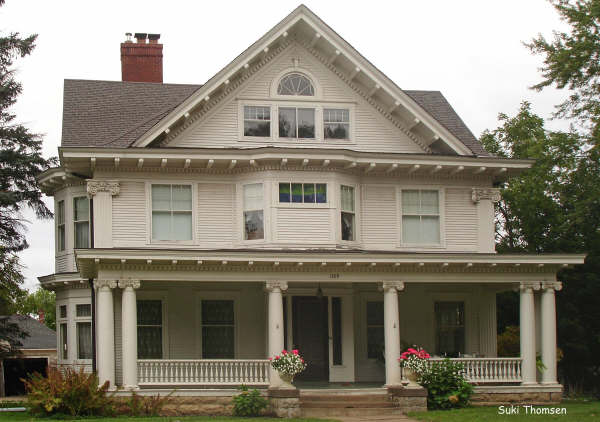Landmark Site
James D. and Susan Bronson House
For all the many old distinguished residences in Stillwater, there are very few that were designed by architects--or at least, very few that are known to have been designed by architects. This house was built in 1905 for James D. and Susan Bronson.
The second generation of a lumbering family that prospered in the St. Croix Valley, James was born in Stillwater, November 25, 1869, the son of David and Ianthe Davis Bronson. After an education that included Shattuck School in Faribault, he began work with the East Side Lumber Company. When that company was disbanded in 1906, Bronson, along with the other owners, donated the riverfront property to the city of Stillwater. Today the property is known as Kolliner Park.
Throughout his life, James held a number of commercial positions both here in Stillwater and on the West Coast, including President of the Consolidated Lumber Company, Vice-President of the McGoldsick Lumber Company of Spokane, Treasurer of the Yellow Pine Company, and Vice-President of the Bronson-Folsom Towing Company. He was a director of several banks, including the First National Bank in St. Paul.
He was also active in local civic affairs, including a director of the Stillwater Hotel Company which constructed the Lowell Inn; he served an active role as a member of the Board of Education, and he was a Senior Warden of Ascension Episcopal Church. He might be termed a member of Stillwater’s lumbering aristocracy.
The architect for this house was Louis Lockwood, a prolific St. Paul architect who was born and trained in England. Lockwood died in 1907 at the age of 43, two years after designing this house.
The contractor for the house was Frank Linner (pronounced Lin-near). Born in Sweden in September, 1854, Linner immigrated to Stillwater in 1880. Over the years, by himself, or with partners, he was one of the principal contractors in the city. After Frank’s death on July 1, 1925, his son Lawrence carried on the business. Linner, like other contractors in Stillwater, built what the customer wanted; there were no particular patterns or designs unique to his work.
Bronson’s wife, Susan Brown, was born in March of 1871. They were married on October 4, 1893. They had four children who grew up in this house: Estelle, born in July of 1894; David Edward., born in July of 1896; Faith, born in July of 1898; and James Davis born in 1905.
Before moving into this house, the family had lived in a rented home at 718 South Third Street, along with their four children, a servant, and a 15-year-old nurse.
In 1910, five years after moving into this house at 1309 South Third Street, the household consisted of the couple, all four of their children, and two servants: Clara Groth, age 25; and Hattie Fehlow, age 19.
In the 1920 U. S. Census, James’ occupation was recorded as a banker. His daughter, Estelle had left the household, but sons David and James remained, as well as his daughter, Faith. There continued to be two servants: Elma and Annie Fehlow.
By 1930, in the Great Depression, when James was 60 years old, all his children had left the family home, and only he, Susan, and one faithful servant, Elma Fehlow, remained. The value of the house was listed as $10,000. On May 29, 1935, James Bronson died. His obituary in the Stillwater Gazette merited a banner headline, a large front-page photograph and four columns of text. His wife, Susan, outlived him by ten years, dying on June 10, 1945.
The Neoclassical Style of the home James and Susan built in 1905 at 1309 South Third Street was said to have been the result of the couple’s visit to the World’s Columbian Exposition held in Chicago in 1893. The exposition’s planner mandated a classical theme, and many of the best-known architects of the day designed dramatic colonnaded buildings arranged around a central court. The exposition was widely photographed, reported, and attended. Soon these Neoclassical models became the latest fashion throughout the country.
The most prominent elements of the Neoclassical Style evident in Bronson’s house is the full porch with its classical columns, the classical columns on the corners of the house, the decorative elements under the wide overhanging eaves, the Paladian (four-piece) window on the third floor.
There is a story that Bronson obtained redwood siding for his home; the first redwood to be used in Stillwater. The wood proved to be very durable, and the family liked the appearance so much, the siding remained unpainted for many years.
This house might be found along Summit Avenue in St. Paul. It is an unusually grand residence for Stillwater, befitting the lumber aristocracy of this city.
Source(s): Information complied by Donald Empson, Empson Archives on 3/24/2009 City of Stillwater Building Permit Application #1231. There is also some information in the book, Jo, published in 1975 for the Stillwater Bicentennial Commission. Jo Lutz Rollins did a painting of the house at that time. The Stillwater City Directories provided information on Bronson’s occupation. The U.S. Census 1900-1930 supplied information on the residents of the house. His obituary is in the Stillwater Gazette May 29, 1935.
Washington County Parcel Identification Number (PIN): 3303020140110
Common Property Name: James D. and Susan Bronson House
State Historic Preservation Office Inventory Number: WA-SWC-1727
Construction Date: 1905
Builder: Linner, Frank
Architect: Louis Lockwood
Architectural Style: Neoclassical
